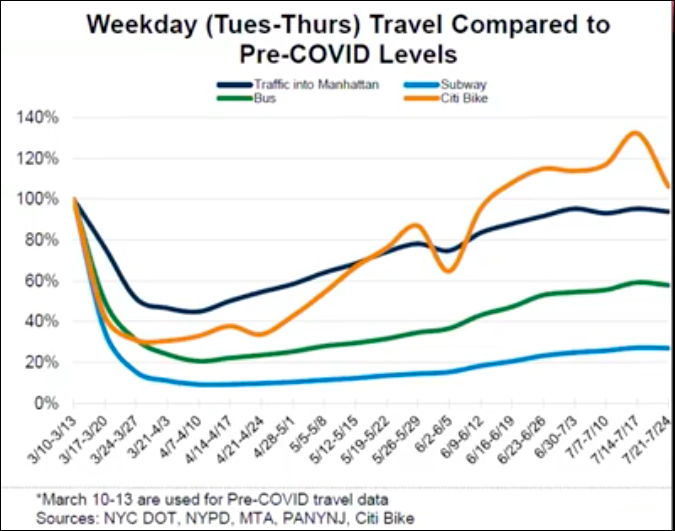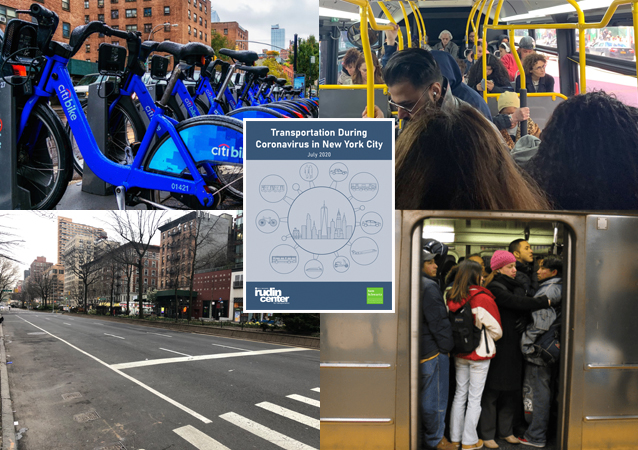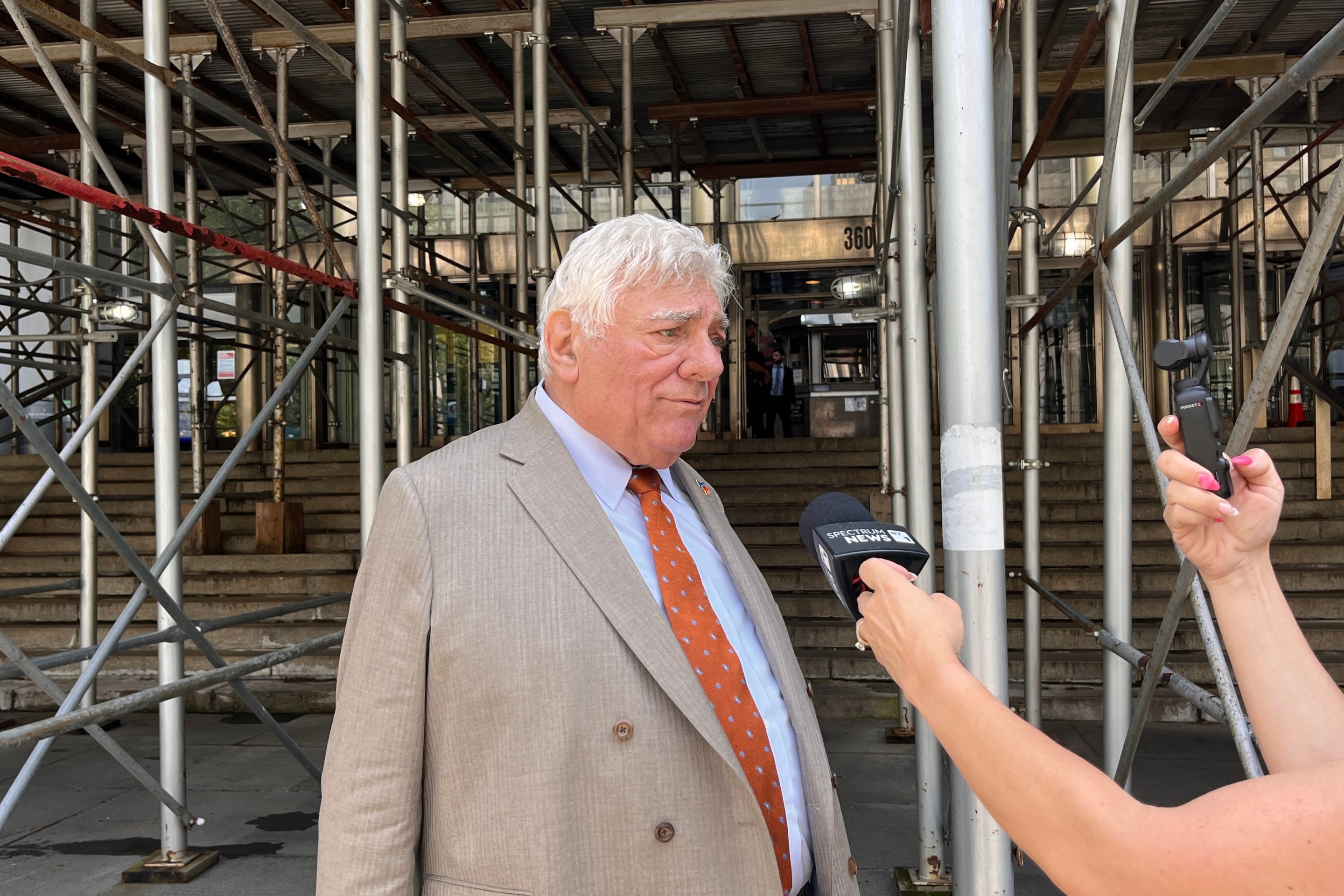New York City is at risk of failing to seize the historic challenge of COVID to create more equity and sustainability in its transportation system, and must quickly add bike and bus lanes, build bike parking, widen sidewalks, reduce speed limits and make driving more expensive, says a new report from two of the city's most influential transportation think tanks.
A detailed analysis of transportation patterns during the coronavirus lockdown led the experts at the Rudin Center for Transportation and Sam Schwartz Transportation Consultants to issue a clarion call of recommendations for improving the city before it is too late [full report PDF]. The recommendations comprise seven major categories, some requiring state action — such as requiring the MTA to keep the subway clean or offering free transfers from the city's ferry system to the subway, not to mention finishing congestion pricing — but most focusing on the de Blasio administration's shortcomings during the crisis.
Going forward, the groups demand that the mayor:
- Make getting around easier:
- Install more Citi Bike docks at subway stations for last-mile transfers.
- Create more parking at unused baseball stadiums, where drivers can leave their cars and take express buses into Manhattan.
- Manage parking better: "When curbside lanes consist of free or low-cost private vehicle parking, the city is providing prime real estate to private users," the report says.
- On-street parking should be priced at a higher rate (and free parking should be reduced) to account for the true cost of vehicle usage and storage. Pricing can be dynamic to incentivize the efficient movement and storage of vehicles, and at a rate that is more aligned with market-rate costs of private garages.
- Get serious about placard abuse, which not only robs the city of revenue, but also "prevents the safe and efficient flow of vehicle, pedestrian and bicycle traffic."
- Create more pick-up and drop-off zones: "New York City ran a successful pilot of this concept in 2019; it should be made permanent and expanded into other areas."
- Make buses better
- Create more "transit-priority corridors" so that essential workers and some of the city's lowest income residents get better service.
- Create more busways beyond the five short strips the mayor announced in June. "Bus Priority lanes should continue to be expanded through the city, with a focus on areas lacking direct access to subway stations," the report said.
- Double down on micromobility (yes, even Revel), but do it smartly
- Add protection for vulnerable road users. "The rise of micromobility highlights the need for protective measures for cyclists. ... The newly implemented temporary bike lanes should be contiguous, protected, marked, and enforced."
- Don't just create open streets for recreation — do it for commuting, too: "As New Yorkers start commuting regularly once more, demand patterns for transportation modes will shift and open streets should reflect this use.
- Encourage pilots and creativity: "As buildout of the Citi Bike network understandably takes time to plan and install, consideration should also be given to implementation of dockless-bike- and scooter-share systems in areas of the city farther from the current Citi Bike service area," the report argues.
- Reduce speed limits now! "In areas with high-density micromobility, new policies will be necessary to assure the safety of our streets. ... The speed of adjacent vehicular traffic ... should be considered."
- Reimagine city streets for people, not cars
- Widen sidewalks — and not only for social distancing, but to encourage walking: "New York City should consider creating additional pedestrian space by expanding sidewalks into parking," the report says.
- Permanently swipe parking for dining: There's an economic benefit, the report says: "Such uses arguably have the potential to stimulate the city’s economy more than private parking. A nominal fee could be charged to restaurants for this space."
"These recommendations seek to mitigate the negative outcomes and improve mobility for traveling to and from work, school, recreation and shopping," the report says. "Our goal is that New Yorkers have safe, efficient and flexible mobility in the short- and long-term."
How bad is it?
The recommendations in the Rudin/Schwartz report are based on detailed analysis of the city's transportation patterns during the crisis — compiled in scores of pages of statistics. Here are the ones that jump out:
- At its lowest ridership in April, transit was down 96 percent from a normal workday. The breakdown:
- The subway was down 91.7 percent.
- Suburban rail was down 97.9 percent.
- Buses were down 78.3 percent.
- Car traffic was only down 65.5 percent — and started rebounding earlier, the report says.
- Manhattan’s Central Business District was hurt the most:
- In April, 2020, travel to the 50 subway stations in Manhattan south of 61st Street declined to 4.4 percent of its normal level.
- Citi Bike trips that ended in Midtown were down 70.5 percent in April, compared to April, 2019. But Citi Bike also rebounded relatively quickly.
- Pedestrian counts in four Manhattan business improvement districts fell by 83.5 percent between March and May, 2020.
- Essential workers needed transit the most.
- Subway ridership in Manhattan fell 93.4 percent.
- Ridership in the Bronx fell "only" 80.6 percent, the least of any borough.
- Revel scooter ridership increased, with 12 percent of the trips being taken by essential workers.
- Driving stuff
- Total vehicle miles in the city decreased by 84, but traffic speeds rose by 27 percent.
- But bus speeds were also up, which suggests what can happen if the mayor would remove more cars. Citywide, buses were 15 percent feaster than over the same period in 2019. In Manhattan, bus speeds were 30 percent better, due in part to reduced vehicle traffic, the report says.

The report comes at a crucial time for transportation in New York. With subway and bus ridership still down significantly from its pre-COVID norms, car traffic into the city is on the rise. Department of Transportation Commissioner Polly Trottenberg mentioned the dilemma in a City Law breakfast on Thursday, where she showed data about the inevitable carpocalypse (see chart, right).
Even though the city has done little to expand bike infrastructure during the crisis, Citi Bike use (orange line) got back to full, pre-COVID numbers relatively quickly. Driving (black line) is almost fully back to the congested mess that it has always been, but subway (blue line) and bus ridership (green line) remains way down.
What is to be done?
The report acknowledges that there are "intense financial pressures ... that constrain current programs and new initiatives," but such pressures exist in every city on the planet. Yet many cities have been able to radically transform their transportation options to not only ease mobility during the crisis, but set up the city for a more sustainable future.
In Paris, Mayor Anne Hidalgo was re-elected last month on a platform of transforming the city from a car-choked mess into a livable place dominated by walking, transit and biking. She's building 403 miles of new cycle routes and creating car-free streets to improve bus times. Meanwhile, in London, Mayor Sadiq Khan has banished cars from the city center and is doubling-down on his "Healthy Streets" initiative.
Mayor de Blasio is not committed to such radical transformation — and, in fact, cut funding to his own "Green Wave" and "Better Bus Initiative" plans as the coronavirus crisis hit. On Thursday, Streetsblog asked him why his administration has not followed the leads of London and Paris to plot a future that the mayor himself says he wants.
"New York City is just a different place," he said. "We're going to make decisions based on our particular reality."
That reality does include creating roughly 70 miles of temporary open streets and temporary protected bike lanes and adding several miles of car-free busways, but such measures are minuscule compared to other cities. And — fact check — the open streets tend to favor the rich and are inconsistently maintained, the barrel-protected bike lanes are not fool-, or cop-, proof, and none of the new busways has been built yet (and only the 14th Street busway is permanent).
But the mayor pressed on:
"I think everyday people can see these changes and feel these changes, and my goal is to see how far we can take all of them," he said.






